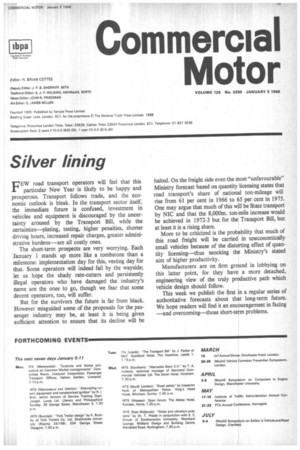Silver lining
Page 17

If you've noticed an error in this article please click here to report it so we can fix it.
FEW road transport operators will feel that this particular New Year is likely to be happy and prosperous. Transport follows trade, and the economic outlook is bleak. In the transport sector itself, the immediate future is confused, investment in vehicles and equipment is discouraged by the uncertainty aroused by the Transport Bill, while the certainties—plating, testing, higher penalties, shorter driving hours, increased repair charges, greater administrative burdens—are all costly ones.
The short-term prospects are very worrying. Each January 1 stands up more like a tombstone than a milestone: implementation day for this, vesting day for that. Some operators will indeed fall by the wayside; let us hope the shady rate-cutters and persistently illegal operators who have damaged the industry's name are the ones to go, though we fear that some decent operators, too, will suffer.
But for the survivors the future is far from black. However misguided some of the proposals for the passenger industry may be, at least it is being given sufficient attention to ensure that its decline will be halted. On the freight side even the most "unfavourable" Ministry forecast based on quantity licensing states that road transport's share of national ton-mileage will rise from 61 per cent in 1966 to 65 per cent in 1975. One may argue that much of this will be State transport by NIC and that the 8,000m. ton-mile increase would be achieved in 1972-3 but for the Transport Bill, but at least it is a rising share.
More to be criticized is the probability that much of this road freight will be carried in uneconomically small vehicles because of the distorting effect of quantity licensing—thus mocking the Ministry's stated aim of higher productivity.
Manufacturers are on firm ground in lobbying on this latter point, for they have a more detached, engineering view of the truly productive path which vehicle design should follow.
This week we publish the first in a regular series of authoritative forecasts about that long-term future. We hope readers will find it an encouragement in facing —and overcoming—those short-term problems.










































































































